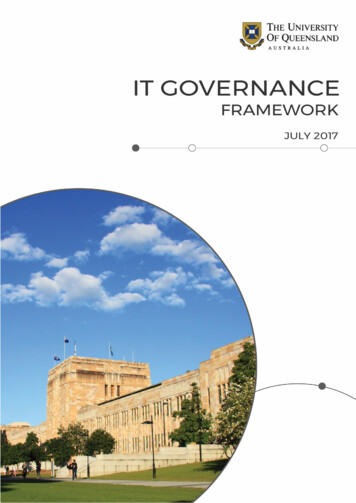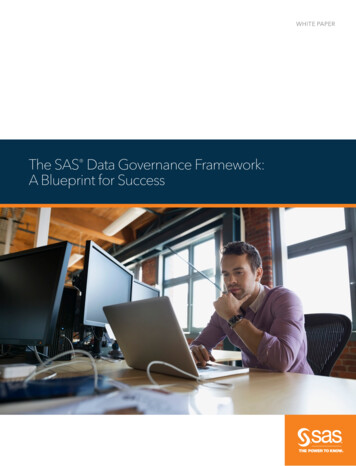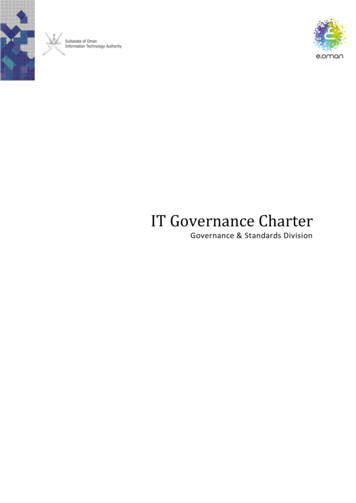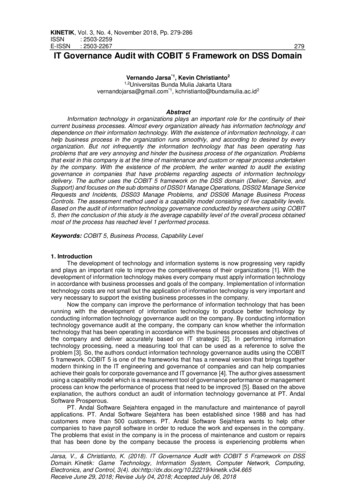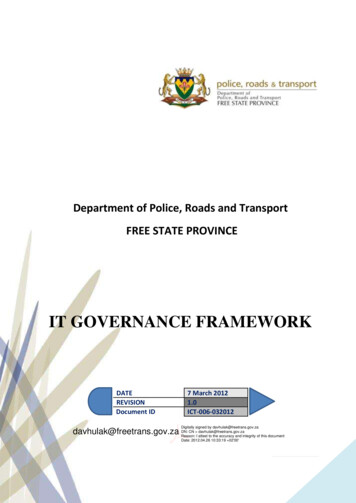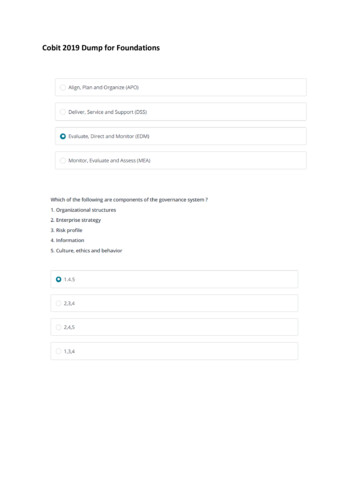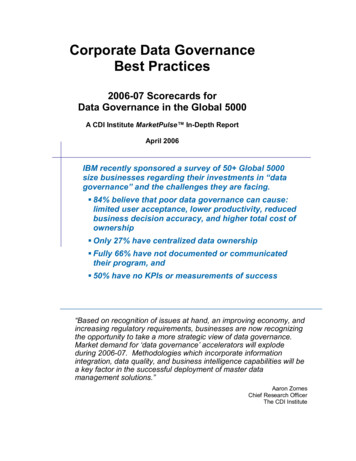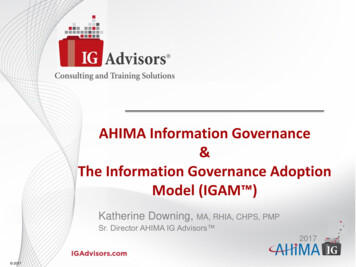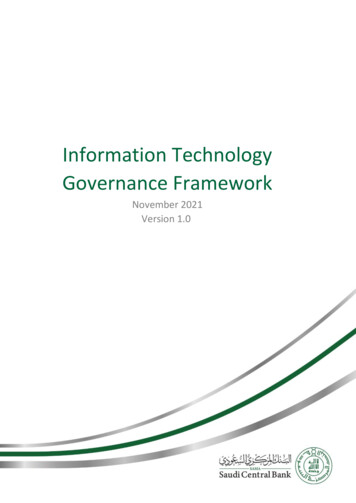
Transcription
Information TechnologyGovernance FrameworkNovember 2021Version 1.0
Table of Contents1.2.3.Introduction. 41.1Introduction to the Framework . 41.2Definition of Information Technology Governance . 41.3Scope. 41.4Applicability . 51.5Responsibilities . 51.6Interpretation . 51.7Target Audience . 51.8Review, Updates and Maintenance . 51.9Reading Guide . 5Framework Structure and Features . 52.1Structure . 52.2Principle-based . 62.3Self-Assessment, Review and Audit . 72.4Information Technology Governance Maturity Model. 72.4.1Maturity Level 3 . 82.4.2Maturity Level 4 . 82.4.3Maturity Level 5 . 9Control domains . 103.13.1.1Information Technology Governance . 103.1.2Information Technology Strategy . 113.1.3Manage Enterprise Architecture . 113.1.4Information Technology Policy and Procedures . 123.1.5Roles and Responsibilities. 123.1.6Regulatory Compliance . 133.1.7Internal IT Audit . 133.1.8Staff Competence and Training . 143.1.9Performance Management . 143.2IT Risk Management . 153.2.1Managing IT Risks. 153.2.2Risk Identification and Analysis . 163.2.3Risk Treatment . 163.2.4Risk Reporting, Monitoring, and Profiling. 173.32Information Technology Governance and Leadership . 10Operations Management. 17
3.3.1Manage Assets . 173.3.2Interdependencies . 183.3.3Manage Service Level Agreements . 193.3.4IT Availability and Capacity Management . 193.3.5Manage Data Center . 203.3.6Network Architecture and Monitoring . 203.3.7Batch Processing . 213.3.8IT Incident Management. 223.3.9Problem Management . 233.3.10Data Backup and Recoverability . 233.3.11Virtualization . 243.4System Change Management . 253.4.1System Change Governance . 253.4.2Change Requirement Definition and Approval . 263.4.3System Acquisition . 263.4.4System Development . 273.4.5Testing. 273.4.6Change Security Requirements. 283.4.7Change Release Management . 283.4.8System Configuration Management . 293.4.9Patch Management. 293.4.10IT Project Management . 303.4.11Quality Assurance . 31Appendices . 32Appendix A - How to request an Update to the Framework . 32Appendix B – Framework Update request form . 33Appendix C - How to request a Waiver from the Framework . 34Appendix D – Framework Waiver request form . 35Appendix E – Glossary. 363
1. Introduction1.1 Introduction to the FrameworkThe current digital society has high expectations of flawless customer experience and continuousavailability of services. The advancement of information technology (“IT”) has brought rapid changes tothe way businesses and operations are being conducted in the financial sector. Although IT plays anessential role combined with today’s environment, it also exposes financial institutions to dynamicallyevolving IT risks.In this regard, Saudi Central Bank (“SAMA”) has established an Information Technology GovernanceFramework (“the Framework”) to enable organizations regulated by SAMA (“the Member Organizations”)to effectively identify and address risks related to IT. The objective of the Framework is as follows:1. To create a common approach for addressing IT risks within the Member Organizations.2. To achieve an appropriate maturity level of IT controls within the Member Organizations.3. To ensure IT risks are properly managed throughout the Member Organizations.The framework will be used to periodically assess the maturity level and evaluate the effectiveness of theIT controls at Member Organizations. The framework is based on the SAMA requirements and industry ITstandards.1.2 Definition of Information Technology GovernanceAn Information Technology (IT) governance ensures the effective and efficient use of IT to enable MemberOrganizations to achieve its goals and objectives. It enables Member Organizations formulating optimalvalue from IT by maintaining a balance between realizing benefits and optimizing risk levels and resourceuse.1.3 ScopeThe framework defines principles and objectives for initiating, implementing, maintaining, monitoringand improving IT governance controls within Member Organizations regulated by SAMA. The frameworkoffers IT governance controls requirements which are applicable to the information assets of the MemberOrganizations. Additionally, the framework provides direction for IT Governance requirements forMember Organizations and its subsidiaries, staff, third parties and customers. The framework should beimplemented in conjunction with SAMA’s Cyber Security and Business Continuity framework respectively(figure 1). For specific Cyber Security and Business Continuity related requirements please refer to SAMA’sCyber Security Framework and Business Continuity Management Framework.Figure 1 – Relationship between SAMA Frameworks4
The Framework has an interrelationship with other corporate policies for related areas, such as changemanagement and staff training. This framework does not address the non-IT requirements for thoseareas.1.4 ApplicabilityThe framework is applicable to Member Organizations regulated by SAMA.1.5 ResponsibilitiesThe framework is mandated by SAMA and will be circulated to Member Organizations forimplementation. SAMA is the owner and is responsible for periodically updating the framework. TheMember Organizations are responsible for implementing and complying with the framework.1.6 InterpretationSAMA, as the owner of the framework, is solely responsible for providing interpretations of the principlesand Control Requirements, if required.1.7 Target AudienceThe Framework is intended for senior and executive management, business owners, owners ofinformation assets, CIOs and those who are responsible for and involved in defining, implementing andreviewing IT controls within the Member Organizations.1.8 Review, Updates and MaintenanceSAMA will review the Framework periodically to determine the Framework’s effectiveness, including theeffectiveness of the Framework to address emerging IT threats and risks. If applicable, SAMA will updatethe Framework based on the outcome of the review.If a Member Organization considers that an update to the framework is required, the MemberOrganization should formally submit the requested update to SAMA. SAMA will review the requestedupdate, and when applicable, the Framework will be adjusted on the next updated version.The Member Organization will remain responsible to be compliant with the framework pending the nextversion update.Please refer to ‘Appendix A – How to request an Update to the Framework’ for the process of requestingan update to the Framework.Version control will be implemented for maintaining the framework. Whenever any changes are made,the preceding version shall be retired and the new version shall be published and communicated to allMember Organizations. For the convenience of the Member Organizations, changes to the frameworkshall be clearly indicated.1.9 Reading GuideThe Framework is structured as follows. Chapter 2 elaborates on the structure of the Framework, andprovides instructions on how to apply the Framework. Chapter 3 presents the actual framework, includingthe IT domains and subdomains, principles, objectives and Control Requirements.2. Framework Structure and Features2.1 StructureThe Framework is structured around four main domains, namely: 5Information Technology Governance and Leadership.Information Technology Risk Management.
Information Technology Operations Management.System Change Management.For each domain, several subdomains are defined. A subdomain focusses on a specific IT governance topic.Per subdomain, the Framework states a principle and Control Requirements. A Principle summarizes the main set of required IT controls related to the subdomain.The Control Requirements reflects the mandated IT controls that should be considered.The framework should be implemented in view of principles mentioned in per subdomains along with itsassociated Control Requirements.Control Requirements have been uniquely numbered according to the following numbering systemthroughout the Framework:Figure 2 – Control requirements numbering systemThe figure below illustrates the overall structure of the Framework and indicates the IT Governance Frameworkdomains and subdomains, including a reference to the applicable section of the Framework.Figure 3 – Information Technology Governance Framework2.2 Principle-basedThe framework is principle based, also referred to as risk based. This means that it prescribes key IT governanceprinciples and objectives to be embedded and achieved by the Member Organizations. The list of mandatedControl Requirements provides additional direction and should be considered by the Member Organizationsin achieving the objectives. When a certain control requirements cannot be tailored or implemented, the6
Member Organizations should consider applying compensating controls, pursuing an internal risk acceptanceand requesting a formal waiver from SAMA. Please refer to Appendix D for details for the – How to request aWaiver from the Framework – process.2.3 Self-Assessment, Review and AuditThe implementation of the framework at the Member Organizations will be subject to a periodic selfassessment. The self-assessment will be performed by the Member Organizations based on a questionnaire.The self-assessments will be reviewed and audited by SAMA to determine the level of compliance with theframework and the IT maturity level of the Member Organizations. Please refer to ’2.4 Information TechnologyGovernance Maturity Model’ for more details about the information technology governance maturity model.2.4 Information Technology Governance Maturity ModelThe Information Technology Governance maturity level will be measured with the help of a predefinedmaturity model. The information technology governance maturity model distinguishes 6 maturity levels (0, 1,2, 3, 4 and 5), which are summarized in the table below. In order to achieve levels 3, 4 or 5, MemberOrganizations should first meet all criteria of the preceding maturity levels.Maturity LevelDefinition and CriteriaExplanation0Non-existent No documentation. IT controls is not or partially defined.1Ad-hoc The execution of the IT control is based on aninformal and unwritten, though standardized,practice.2Repeatable butinformal3Structured andformalized4Managed andmeasurableIT controls are not in place. There may be no awareness ofthe particular risk area or no current plans to implementsuch IT controls. IT control design and execution varies by department orowner. IT control design may only partially mitigate the identifiedrisk and execution may be inconsistent. Repeatable IT controls are in place. However, the controlobjectives and design are not formally defined orapproved. There is limited consideration for a structured review ortesting of a control. IT policies, standards and procedures are established. Key performance indicators are defined, monitored andreported to evaluate the implementation.There is no awareness or attention for certaininformation technology control.IT controls are performed in an inconsistent way.IT controls are not fully defined. IT controls are defined, approved and implementedin a structured and formalized way. The implementation ofdemonstrated.ITcontrols canbeCompliance with IT documentation i.e., policies, standardsand procedures is monitored, preferably using agovernance, risk and compliance tool (GRC). The effectiveness of the IT controls are periodicallyassessed and improved when necessary. Effectiveness of IT controls are measured and periodicallyevaluated. This periodic measurement, evaluations andopportunities for improvement are documented. Key risk indicators and trend reporting are used todetermine the effectiveness of the IT controls. Results of measurement and evaluation are used toidentify opportunities for improvement of the IT controls. The enterprise-wide IT governance program focuses oncontinuous compliance, effectiveness and improvement ofthe IT controls. IT controls are integrated with enterprise risk managementframework and practices. Performance of IT controls are evaluated using peer andsector data. 5 Adaptive IT controls are subject to a continuous improvementplan.Table 1 - Information technology governance Maturity Model7
2.4.1 Maturity Level 3To achieve level 3 maturity, a Member Organization should define, approve and implement IT controls. Inaddition, it should monitor compliance with the IT documentation. The IT documentation should clearlyindicate “why”, “what” and “how” IT controls should be implemented. The IT documentation consists of ITpolicies, standards and procedures.Figure 4 – Information Technology Documentation PyramidThe IT policy should be endorsed and mandated by the board of the Member Organization and stating “why”IT is important to the Member Organization. The policy should highlight which information assets should beprotected and “what” IT principles and objectives should be established.Based on the IT policy, IT standards should be developed. These standards define “what” IT controls should beimplemented, such as, segregation of duties, back-up and recovery rules, etc. The standards support andreinforce the IT policy and are to be considered as IT baselines.The step-by-step tasks and activities that should be performed by staff of the Member Organization aredetailed in the IT procedures. These procedures prescribe “how” the IT controls, tasks and activities have tobe executed in the operating environment.The process in the context of this framework is defined as a structured set of activities designed to accomplishthe specified objective. A process may include policies, standards, guidelines, procedures, activities and workinstructions, as well as any of the roles, responsibilities, tools and management controls required to reliablydeliver the output.The actual progress of the implementation, performance and compliance of the IT controls should beperiodically monitored and evaluated using key performance indicators (KPIs).2.4.2 Maturity Level 4To achieve maturity level 4, Member Organizations should periodically measure and evaluate the effectivenessof implemented IT controls. In order to measure and evaluate whether the IT governance controls are effective,key risk indicators (KRIs) should be defined. A KRI indicates the norm for effectiveness measurement and shoulddefine thresholds to determine whether the actual result of measurement is below, on, or above the targetednorm. KRIs are used for trend reporting and identification of potential improvements.8
2.4.3 Maturity Level 5Maturity level 5 focuses on the continuous improvement of IT controls. Continuous improvement is achievedthrough continuously analyzing the goals and achievements of IT governance and identifying structuralimprovements. IT controls should be integrated with enterprise risk management practices and supported withautomated real-time monitoring. Business process owners should be accountable for monitoring thecompliance of the IT controls, measuring the effectiveness of the IT controls and incorporating the IT controlswithin the enterprise risk management framework. Additionally, the performance of IT controls should beevaluated using peer and sector data.9
3. Control domains3.1 Information Technology Governance and LeadershipMember Organizations board is ultimately responsible for setting the Information Technology (IT) Governanceand ensuring that IT risks are effectively managed within the Member organization. The board of the MemberOrganization can delegate its IT Governance responsibilities to senior management or IT steering committee(ITSC). The ITSC could be responsible for defining the IT governance and setting the Member Organization’s ITstrategy.3.1.1 Information Technology GovernancePrincipleAn IT Governance structure should be defined, endorsed and supported with appropriate resources tooversee and control the Member Organization's overall approach to Information Technology.Control Requirements1. Member organizations should establish ITSC and be mandated by the board.2. The ITSC should be headed by senior manager responsible for Member Organizations operations.3. The following positions should be represented in the ITSC:a. senior managers from all relevant departments (e.g., CRO, CISO, compliance officer, heads of relevantbusiness departments);b. Chief Information Officer (CIO); andc. Internal Audit may attend as an “observer”.4. An ITSC charter should be developed, approved and reflect the following:a. committee objectives;b. roles and responsibilities;c. minimum number of meeting participants;d. meeting frequency (minimum on quarterly basis); ande. documentation and retention of meeting minutes and decisions.5. A full-time senior manager for the IT function, referred to as CIO, should be appointed at seniormanagement level.6. The Member Organizations should:a. ensure the CIO is a Saudi national;b. ensure the CIO is sufficiently qualified; andc. obtain a written no objection letter from SAMA prior to assigning the CIO.7. The Member Organizations should establish formal practices for IT-related financial activities coveringbudget, cost, and prioritization of spending aligned with IT strategic objectives.8. The overall IT budget should be monitored, reviewed periodically and adjusted accordingly to meet the ITand business needs.9. Member Organizations should define roles and responsibilities of senior management and IT staff using aresponsibility assignment matrix, also known as RACI. The RACI matrix should outline who are responsibleand accountable for the functions, as well as who should be consulted or informed.10. Member organizations should define enterprise architecture reflecting fundamental components of thebusiness processes and its supporting technology layers to ensure responsive and efficient delivery ofstrategic objectives.11. Member Organizations should define enterprise application architect role within the IT function to identifythe required changes to the portfolio of applications across the member organizations ecosystem.12. Roles and responsibilities within IT function should be:a. documented and approved by the management; andb. segregated to avoid conflict of interest.10
13. Member Organizations should develop formal IT succession plan in coordination with Human Resource (HR)Department taking into consideration the reliance on a key IT staff having critical roles and responsibilities.3.1.2 Information Technology StrategyPrincipleAn IT strategy should be defined in alignment with the Member Organization’s strategic objectives and incompliance with legal and regulatory requirements.Control Requirements1. IT strategy should be defined, approved, maintained and executed.2. IT strategic initiatives should be translated into defined roadmap considering the following:a. the initiatives should require closing the gaps between current and target environments;b. the initiatives should be integrated into a coherent IT strategy that aligns with the business strategy;c. the initiatives should address the external ecosystem (enterprise partners, suppliers, start-ups, etc.);andd. should include determining dependencies, overlaps, synergies and impacts among projects, andprioritization.3. IT strategy should be aligned with:a. the Member Organization’s overall business objectives; andb. legal and regulatory compliance requirements of the Member Organization.4. IT strategy at minimum should address:a. the importance and benefits of IT for the Member Organization;b. the current business and IT environment, the future direction, and the initiatives required to migrate tothe future state environment; andc. interdependencies of the critical information assets.5. Member organization should identify IT strategic and emerging technology risks that may have impact onthe achievement of overall organization wide strategic objectives.6. Member organization should enhance skill sets and expertise (operational and technical) of the existingresources through providing periodic training on emerging technologies and if required to have the relevantresources on boarded in line with member organization direction towards digitalization.7. IT strategy should be reviewed and updated periodically or upon material change in the MemberOrganizations operational environment, change in business strategy, objectives or amendment in laws ®ulations.3.1.3 Manage Enterprise ArchitecturePrincipleEnterprise architecture should be defined which outlines fundamental components of the business processes,data and supporting technology layers to ensure responsive and efficient delivery of Member organizations ITstrategic objectives.Control Requirements1. The enterprise architecture should be defined, approved and implemented.2. The compliance with the enterprise architecture should be monitored.3. The enterprise architecture should address the following, but not limited to:a. a strategic outline of organizations technology capabilities;b. outline the gaps between baseline and target architectures, taking both business and technicalperspectives; andc. agility to meet changing business needs in an effective and efficient manner.11
3.1.4 Information Technology Policy and ProceduresPrincipleIT policy and procedures should be defined, approved, communicated and implemented to set memberorganizations commitment and objectives to IT and communicated to the relevant stakeholders.Control Requirements1. IT policy and procedures should be defined, approved, communicated, and implemented.2. IT policy and procedures should be reviewed periodically taking into consideration the evolving technologylandscape.3. IT Policy should be developed considering input from relevant member organizations policies (e.g. cybersecurity, finance, HR).4. IT Policy should include:a. the Member Organization’s overall IT objectives and scope;b. a statement of the board’s intent, supporting the IT objectives;c. a definition of general and specific responsibilities for IT; andd. the reference to supporting IT (inter)national standards and process (where applicable).3.1.5 Roles and ResponsibilitiesPrincipleIT roles and responsibilities should be defined and all parties involved in the Member Organization's IT processesshould have an adequate level of understanding of the expectations related to their role.Control Requirements1. The board should be accountable for:a. the ultimate responsibility for the establishment of IT governance practice;b. ensuring that robust IT risk management framework is established and maintained to manage IT risks;c. ensuring that sufficient budget for IT is allocated;d. approving the IT steering committee (ITSC) charter; ande. endorsing (after being approved by the ITSC):1. the governance and management practices roles and responsibilities;2. the IT strategy; and3. the IT policy.2. ITSC, at a minimum, should be responsible for:a. mo
The Framework has an interrelationship with other corporate policies for related areas, such as change management and staff training. This framework does not address the non-IT requirements for those areas. 1.4 Applicability The framework is applicable to Member Organizations regulated by SAMA. 1.5 Responsibilities
